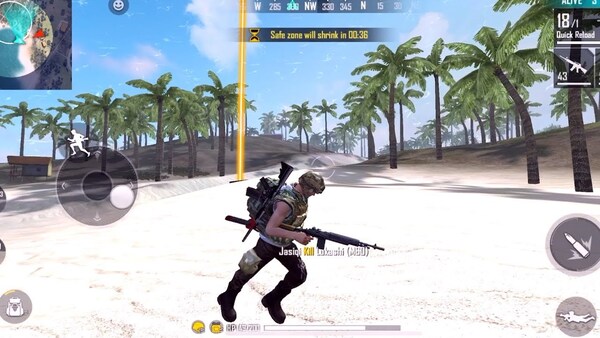Popular Now
In the world of REMATCH game, success isn't just determined by reflexes or loadouts — it's built on a deep understanding of team roles and how players fulfill them in competitive scenarios. The game’s role system is designed to promote cohesion, tactical synergy, and specialized playstyles. Whether you're grinding the ranked ladder or battling in tournaments, understanding how each role operates is crucial for unlocking your team's full potential.
This article takes a deep dive into REMATCH’s role-based system and how it shapes gameplay, team composition, and competitive strategy.
Origins of the Role System in REMATCH
REMATCH game didn’t start with a role system — it evolved into one as the player base matured and strategies deepened. Early gameplay centered around raw firepower and mobility. Over time, however, developers observed an emerging need for structure, prompting the introduction of designated roles.
The role system was introduced in Season 3 and immediately shifted the meta. Teams could now build around complementary strengths, which elevated the competitive ceiling. The current role system supports diverse strategies, allowing each player to specialize while still being vital to team success.

Why a Role System Matters
Roles create balance in high-pressure matches. Instead of five random attackers charging into battle, REMATCH encourages synergy through diversity:
-
Some roles focus on damage output
-
Others specialize in control or disruption
-
Supportive roles help with healing, shielding, or utility
This design not only rewards teamwork but also ensures replayability and tactical variety.
Overview of the Five Core Roles
REMATCH game features five main roles, each built around a specific set of responsibilities. Every hero or agent in the game is categorized under one of these roles.
The Five Roles:
-
Striker – Primary damage dealer, excels in burst and sustained offense
-
Sentinel – Defensive expert, ideal for holding zones and protecting allies
-
Initiator – Disrupts enemy formations and sets up engagements
-
Support – Heals, buffs, or debuffs; crucial for sustaining the team
-
Flex – Hybrid role that adapts based on team needs or matchups
Each of these roles has unique abilities and synergy interactions, making team building more of a puzzle than a popularity contest.
Strikers: The Frontline Finishers
Strikers are often the center of attention — and the first to fall if not supported properly. Their toolkit is geared toward aggressive plays, eliminating targets quickly and swinging momentum.
Striker Playstyle
-
High DPS (damage per second) weapons
-
Speed and vertical mobility tools
-
Frag-oriented ultimates
Top-tier Strikers typically lead in kills but are vulnerable without backup. This role demands precision aiming, positioning awareness, and instinctive target prioritization.
Best Practices for Strikers
-
Time your pushes with Initiators
-
Avoid overextending without utility
-
Use terrain for quick retreats when pressured
Sentinels: Shields and Stalwarts
Sentinels form the defensive backbone of any REMATCH game team. Their goal isn’t to rack up kills but to deny access, protect key zones, and guard vulnerable allies.
Sentinel Capabilities
-
Deployable shields, traps, or barriers
-
Vision control or enemy tracking
-
AoE damage denial zones
A skilled Sentinel controls the flow of the game by slowing enemy aggression and keeping teammates alive longer. They are particularly strong in objective-based modes.
Sentinel Mindset
-
Think like a wall: know when to stand firm
-
Anchor strategic points like capture zones or respawn sites
-
Don’t chase kills — play the long game
Initiators: Chaos Creators
Initiators are the catalysts of combat. Their role is to start fights on their terms, breaking enemy formations and exposing vulnerabilities for Strikers to exploit.
What Makes a Good Initiator
-
Area denial grenades or shockwaves
-
Enemy displacement tools (grapples, pulls, jumps)
-
Debuffs that soften opponents before a clash
Their job isn’t to survive — it’s to break lines and confuse enemies, enabling favorable engagements. Most successful Initiators are bold, fast thinkers who understand enemy positioning better than most.
Coordination Is Key
-
Always sync with your Striker before committing
-
Use audio cues and timing to catch multiple enemies in your zone
-
Fall back quickly — don’t linger after initiating
Supports: The Unsung Heroes
Support players in REMATCH game are the glue that holds a team together. Their toolkit might not deal much damage, but it saves lives, enhances allies, and wins long fights.

Support Utility
-
Healing fields, stim boosts, or armor buffs
-
Revive beacons or resurrection drones
-
Vision or enemy tagging mechanics
Despite often being the lowest on the scoreboard, Supports are the highest in strategic impact, especially in prolonged battles or attrition-based modes.
Survival and Smart Use
-
Stay in the backline but keep moving
-
Save heals for turning points, not topping up
-
Use utility proactively, not reactively
Flex: The Wildcard Role
Flex is REMATCH’s most versatile role. Players in this slot adjust to fill gaps in their team’s strategy, often switching heroes between rounds.
Characteristics of a Flex Player
-
Deep knowledge of multiple roles
-
Fast adaptability based on map and enemy comp
-
Prioritizes team needs over personal stats
In high-ranked or tournament games, Flex players are often shot callers or strategic anchors, filling in whatever role is needed per matchup.
How to Excel at Flex
-
Learn one hero from each role
-
Watch enemy picks and counter accordingly
-
Communicate role swaps in pre-round chat
Role-Based Synergy and Composition
A winning team isn’t made of five superstars — it’s made of complementary pieces that fit together. REMATCH rewards teams that build with intention.
Recommended Team Composition
-
1 Striker
-
1 Sentinel
-
1 Initiator
-
1 Support
-
1 Flex (usually backup Striker or Sentinel)
This setup ensures aggression, defense, control, and sustainability, giving your team a fighting chance against any lineup.
Understanding Meta Trends
Every season shifts the ideal compositions slightly due to:
-
Hero buffs/nerfs
-
Map design changes
-
New agent introductions
Players should adjust accordingly to stay on top.
Communication and Role Responsibility
Even the perfect comp will fall apart without proper communication. REMATCH’s in-game pings, quick chat wheels, and mic systems all exist to support this.
Role-Specific Calls
-
Strikers call out low-health enemies
-
Sentinels alert for flankers or breaches
-
Supports track cooldowns or healing zones
-
Flex players adapt based on incoming data
Consistent communication helps avoid overlaps and missed opportunities — especially in high-speed situations.
Adapting Your Role to Map Types
Not every map in REMATCH plays the same. Urban zones, open fields, and vertical arenas each demand a tailored approach.

Example Adaptations
-
Sentinels thrive in tight chokepoints
-
Strikers flourish on open sightlines
-
Initiators are key in maps with complex terrain
-
Supports must position where line-of-sight can reach all allies
Learning to map-role pair is an advanced skill that separates casual players from professionals.
Role Progression and Mastery Rewards
REMATCH encourages players to specialize in roles through its Role Mastery system, introduced in Season 5.
Earning Role XP
-
Completing role-specific tasks
-
Earning MVP votes in your category
-
Maintaining high impact stats
Leveling up roles unlocks:
-
Exclusive emblems and banners
-
Voice lines or finishers
-
Custom HUD themes for each role
This system adds long-term goals and visual prestige for players who stick to their craft.

Conclusion: Strategy Is a Team Sport
REMATCH's role system transforms every match into a coordinated battle of synergy vs. chaos. Mastering your role, understanding team composition, and adapting to maps and metas are the building blocks of competitive greatness.
Whether you prefer launching the perfect flank as an Initiator or holding the line as a Sentinel, every role matters. Play it right, and you won’t just win — you’ll win with style and purpose.


















